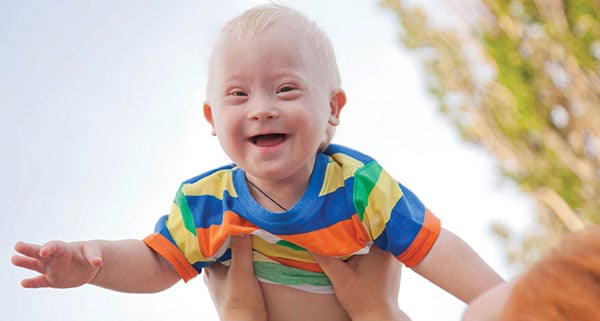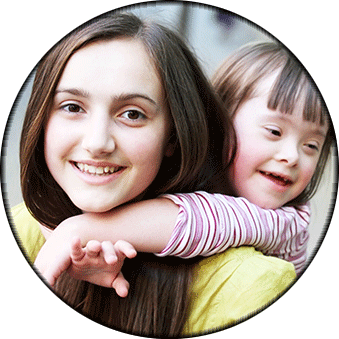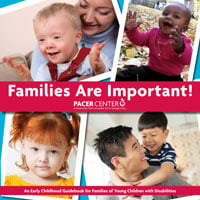Goals in an Individualized Family Service Plan Are Based on the ______ of the Family.

Individualized Family Service Plan
The Individualized Family Service Plan — the "IFSP" — is the center of early intervention. A written plan, called an IFSP, is developed past a team to record the family unit'south outcomes for themselves and their kid. It lists the early on intervention services that volition best assist reach those outcomes and describes when, where, and how those services will exist delivered. Information technology volition be a map to guide you and the professionals working with you.
The IFSP should be the event of cooperative planning between y'all and the team of other people who are learning about your kid. You will work together with professionals to notice what you demand to help your family attain your goals.
The purpose of the IFSP coming together is to talk well-nigh, as a squad, all important information, concerns, and resources. Your child's evaluation and assessment results will be discussed as well as the results of the family unit needs assessment. Other topics volition include outcomes for your child and family, what services are needed, and how the services will be provided.
The IFSP squad will talk virtually your child'south strengths and needs. What are the concerns? What is your kid'south present level of development? You volition share your ideas with the team. The people at the meeting volition likewise talk about what your child tin can do. These are his or her strengths. Be certain to tell them what yous think your child does well!
Hither's what should happen:
- Your family's strengths and resources will be used every bit edifice blocks.
- Y'all will be asked for your ideas, concerns, and priorities.
- You will be invited to meetings.
- Yous will know who to call for assistance.
- Your priorities, beliefs, and values will be honored.
- Your hopes will exist encouraged.

An IFSP is:
- Both a process and a document
- A plan of services and supports
- A help for families and children in their natural daily environments
Ready … Set … Go!
To prepare for the IFSP coming together, the service coordinator will talk with you about who you would like to attend the meeting, what the agenda will be, and the coming together fourth dimension and location. The coordinator will as well make arrangements for the meeting and notify all squad members in writing.
Meetings should be at a fourth dimension and a place that is convenient for you. If information technology is scheduled at a fourth dimension that is non skillful for you, let the coordinator know so it can be re-scheduled. There also might exist more one coming together.
In order to develop a skilful IFSP, you and other members of the team will need to share information about your kid. As the parent, you lot volition need to think about:
- What you want your child to learn
- What help he or she needs
- Other areas in which your child and family may demand support (for case, sibling concerns or how to talk to other family members well-nigh your child's disability)
- Who yous would like on the IFSP team
Think well-nigh these things advisedly. Is at that place anything that the team should know before the IFSP meeting? Call the coordinator or your contact person and let him or her know your thoughts.
Who Will Be In that location?
There will be a coming together to plan the IFSP, and you should be there. Besides you, the team must include the service coordinator and at to the lowest degree one person who was involved in doing the evaluation. Y'all may invite other people to the meeting who know your kid or could help decide what services would help him or her. They may include:

- Child intendance provider
- Doctor or nurse
- Therapist
- Personal care attendant
- Early Head Start teacher
- Advocate
- Others
Who comes to the coming together depends on what your child and your family unit needs and on whom you want to attend. This should be discussed with your coordinator. Non all agencies need to be represented at every meeting.
You can suggest other people who would be helpful in planning for your child and know what he or she needs. It could be someone who cares for your kid, another family member, a friend, or a professional with feel in working with your kid's disability or cultural background.
If you are more comfortable with a smaller number of people at the meeting, share your preferences with the coordinator.
Outcomes: Desired Changes for My Child and Family
Outcomes depict changes desired by your family unit. You and the squad will talk about what you promise your child volition attain. Outcomes are always identified and written before the word about services. You can also identify outcomes for your family. The squad will write these downwards. You will put them in the gild of what is most of import. Here is what an outcome could expect similar: "Sam will learn to sit upwardly so that he tin can..."
Outcomes should describe the family routine or action during which the child and family will piece of work on reaching the issue.
Objectives: How We Volition Achieve the Outcome
You and other team members volition list at least two objectives for each issue. Objectives are steps or ways of reaching outcomes. Here's what objectives could look similar:
- "Mrs. Brown volition be taught three exercises that will strengthen Sam's back muscles by May 1."
- "Sam will learn to balance in a sitting position while someone holds his easily by June 15."

Services
Later on you make up one's mind on the outcomes and objectives, you will talk about what kinds of services could help your child do these things. You will talk about different people who could assist make the outcomes and objectives happen. Then you and the team will choice people to work with your child. Yous should be able to have services that fit your values, beliefs, and desired outcomes for your kid.
For case, in order to teach Sam to sit up, the squad decided to have a physical therapist work with Sam and his mother at their home one time a week. The therapist volition teach his mother means to assist Sam sit up.
In Minnesota, early intervention services are provided at no cost to families with eligible children.
Early intervention services are designed to run into the developmental needs of an infant or toddler with a disability or developmental delays and the needs of the family to aid in the child's development. These can include:
- Assistive technology devices and services
- Audiology
- Family preparation, counseling, and dwelling visits
- Health services
- Medical services for diagnosis and evaluation
- Nursing services
- Diet services
- Occupational therapy
- Concrete therapy
- Psychological services
- Service coordination services
- Sign language and cued language services
- Social work services
- Voice communication-linguistic communication pathology
- Transportation and related costs
- Vision services
A child may need more than i service. For instance, in addition to physical therapy, Sam may too need assistive technology. Because he has difficulty using his easily to play, he may demand switch-activated toys. Services could include providing toys for the family to apply, connecting the family to resources for modifying toys, and teaching Sam how to play with these toys.
Interagency cooperation means agencies will work together to pay for the services children need. The school must ensure that early intervention services are provided at no cost to parents. The school may access the kid's private insurance and Medicaid if parents would non incur a financial cost and parents agree to allow the education agency to access their insurance. Health and human services do not fund special didactics services, but they may fund other bachelor services.
Services for your child need to be provided in places where other children would be at the same age. This is called the natural surroundings or the least restrictive environment once your kid turns 3. Natural environments include the home or wherever your child is during the solar day, such as child intendance. Whenever appropriate, your child should have contact with typically developing children of his or her age.
Services can be delivered in a variety of settings. The setting must be appropriate to meet the needs of the kid. Most services for children ages nascency through two are provided in your home (called dwelling-based) or at kid care. Normally beginning at age iii, children receive services in eye-based early childhood special education (ECSE) classrooms or in community-based programs, such as a preschool or Head Start.
If your child needs to exist in the infirmary for a long fourth dimension, you may desire to enquire that services exist provided in that location if advisable.
What Must Be in the IFSP?
- Data about your child's developmental condition or present levels of development
- Family information (with family unit consent)
- Outcomes your kid and family unit will attain and how progress will be measured
- Specific services to meet the needs of the kid and family
- Projected first appointment of services
- Length of each session
- Frequency (number of days or sessions)
- Intensity (individual or grouping setting)
- Method (how services volition exist delivered: direct, indirect, consultative, etc.)
- Location (statement of natural environments in which services will be provided)
- Anticipated elapsing of the service (ordinarily ane year)
- Funding source if other than the school
- Payment arrangements, if any
- Service coordinator's proper noun
- Transition planning activities
- Required signatures (parents and authorized persons for agencies providing services)
In Minnesota, early intervention services are provided in multiple means. Direct services are given by a teacher or a related professional person and provide pedagogy given to the child or family. Consultative services are provided by a instructor or related-services professional to another instructor, related-services professional, or child care provider. Consultative services include cooperative planning and modification and adaptation of materials, equipment, or curriculum. Information technology can too include directly kid contact to monitor, observe, and follow up. In a transdisciplinary model of services, the primary service provider also has available a team of other professionals who can be called upon to discuss your kid'due south developmental progress and appropriate services when needed. In a multidisciplinary model of services, two providers may make joint visits to the family.
You must be offered a selection of programs and services for your child. If the advisable option does non be, one must be created. You do non need to accept inappropriate services or no services because the appropriate choice is not available.
Each family's service plan should be one-of-a-kind created to see your family'south needs and wishes. You tin can cull to utilize some services offered and refuse others.
The squad will then set timelines. When tin you await services to start? How often and where will they be delivered? How long will they concluding? When does the team hope your child and family can achieve the outcomes? When volition your team meet again to review the programme? Services must brainstorm within 30 days of you signing the IFSP.
It is of import to recollect that early intervention services are designed to show families and caregivers how to use learning opportunities that occur during daily routines and activities to teach a child a new skill.
Service Coordination
You will likewise be assigned a service coordinator. The service coordinator may also be your main service provider. He or she volition proceed the IFSP process flowing smoothly by arranging meetings and communicating with team members. He or she will help you locate community resources, data, and other services to assistance your family and your child. You tin call your service coordinator with questions or problems.
The service coordinator assists and enables the child and family unit to receive the rights, procedural safeguards, and services authorized under the state early intervention program.
Later the Meeting
Subsequently the meeting, you volition exist sent a copy of the IFSP, Prior Written Observe and parent consent form. You volition take xiv calendar days to sign and return the parent consent form. Yous determine whether you lot want the services outlined in the IFSP. If you concord, y'all will sign the IFSP and the parent consent form, and the services will begin.
If yous are not happy with the plan, you should point on the parent consent form that you lot disagree with the plan and are requesting a meeting to discuss your concerns. You tin can too phone call or write to your service coordinator almost your concerns. Always keep a copy of any letters you send. Run across "Resolving Differences" in this book for more information.
IFSP Annual Evaluation and Periodic Review
The services you lot concur to will starting time once y'all sign the IFSP. The squad evaluates the IFSP once a twelvemonth. This is sometimes called an annual evaluation.
Also, a periodic review must be done every vi months (or more frequently if needed). Periodic reviews are done past the family and the service coordinator or by the team. The purpose of the periodic review is to look at the progress made toward the outcomes. You will aid decide whether any changes need to be made in outcomes or services.
The service coordinator will schedule the annual evaluation and periodic review and notify the team members nearly these meetings in writing.
Transition Planning at three
Transition planning should brainstorm at least 90 days before your child's third birthday, or, at the team's discretion, up to six months before your child'due south third birthday. This is to help prepare for a smooth move from an early on intervention program to a preschool or other community plan. If your child qualifies, an Individualized Education Plan (IEP) signed past the parents must be in place past your kid's tertiary birthday.
When a child turns three, all special education and related services must be provided in the least restrictive environment (LRE) possible. In planning for the kid's transition to preschool, the team should consider whether or non a child could make appropriate progress in an inclusive environment if the advisable supports and services were provided. Examples of possible preschool programs include public or private preschools and Caput Start centers. The team must justify any decision to provide educational services in a segregated setting.
The IFSP must incorporate a transition plan to help the child and family transition from Part C services. This could be a separate page or it may exist written as transition goals.
Exist a Good Squad Member
Attend all the meetings about your kid.
Learn more than almost your child'southward disability.
Be a skillful listener. Enquire questions. Listen to what other people say about your child.
Share what yous know about your kid. You are an good about your child! Tell the squad what he likes or does not similar, the ways he learns best, and what he does well.
When yous don't agree, talk about it. Look for compromise in ways that are all correct for your child and family unit.
Know your rights.
Keep good records of all meetings and conversations. Date them.
Put requests in writing if you can, and keep copies.
IFSP: Not Written in Stone
Yous tin request to alter the IFSP even after you sign it. The IFSP can be revised any time there is a need to do and then. The IFSP should be flexible enough to change with your child.
 If things aren't working out, telephone call your service coordinator. Tell him or her what is incorrect, and talk about your concerns. A team meeting can be held to make formal additions or changes to the IFSP document.
If things aren't working out, telephone call your service coordinator. Tell him or her what is incorrect, and talk about your concerns. A team meeting can be held to make formal additions or changes to the IFSP document.
Think almost these things before you lot meet:
- Is my child making progress?
- Would changes make things meliorate?
- What changes tin I propose?
For information on solving problems, see "Resolving Differences" in this booklet.
Please note:
At age 3, families in Minnesota who are receiving services from two or more public agencies may asking an interagency services planning meeting to coordinate those services. The purpose of the meeting is to continue the interagency planning procedure beyond the age of 3. Children can continue to receive services under the category of developmental delay until historic period 7.

This data and more can be establish within:
Families are Important! An Early Childhood Guidebook for Families of Young Children
Call to order - $7 or costless to Minnesota parents of children and immature adults with disabilities.
Source: https://www.pacer.org/ec/early-intervention/ifsp.asp
0 Response to "Goals in an Individualized Family Service Plan Are Based on the ______ of the Family."
Postar um comentário